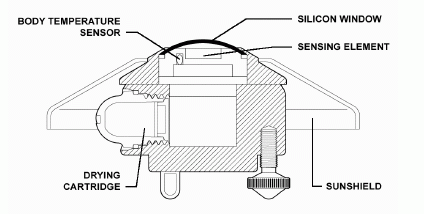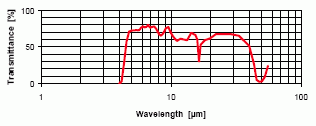
Pyrgeometer
Encyclopedia

Spectrum
A spectrum is a condition that is not limited to a specific set of values but can vary infinitely within a continuum. The word saw its first scientific use within the field of optics to describe the rainbow of colors in visible light when separated using a prism; it has since been applied by...
that extends approximately from 4.5 µm to 100 µm.
Pyrgeometer components

- A thermopileThermopileA thermopile is an electronic device that converts thermal energy into electrical energy. It is composed of several thermocouples connected usually in series or, less commonly, in parallel....
sensor which is sensitive to radiation in a broad range from 200 nm to 100 µm
- A silicon dome or window with a solar blind filter coating. It has a transmittance between 4.5 µm and 50 µm that eliminates solar shortwave radiation.
- A temperature sensor to measure the body temperature of the instrument.
- A sun shield to minimize heating of the instrument due to solar radiation.

Measurement of long wave downward radiation
The atmosphere and the pyrgeometer (in effect the earth surface) exchange long wave IR radiation. This results in a net radiation balance according to:
Where:
 - net radiation at sensor surface [W/m²]
- net radiation at sensor surface [W/m²] - Long-wave radiation received from the atmosphere [W/m²]
- Long-wave radiation received from the atmosphere [W/m²] - Long-wave radiation emitted by the sensor surface [W/m²]
- Long-wave radiation emitted by the sensor surface [W/m²]The pyrgeometer's thermopile
Thermopile
A thermopile is an electronic device that converts thermal energy into electrical energy. It is composed of several thermocouples connected usually in series or, less commonly, in parallel....
detects the net radiation balance between the incoming and outgoing long wave radiation flux and converts it to a voltage according to the equation below.

Where:
 - net radiation at sensor surface [W/m²]
- net radiation at sensor surface [W/m²] - thermopile
- thermopileThermopile
A thermopile is an electronic device that converts thermal energy into electrical energy. It is composed of several thermocouples connected usually in series or, less commonly, in parallel....
output voltage [V]
 - sensitivity/calibration factor of instrument [V/W/m²]
- sensitivity/calibration factor of instrument [V/W/m²]The value for
 is determined during calibration of the instrument. The calibration is performed at the production factory with a reference instrument traceable to a regional calibration center.
is determined during calibration of the instrument. The calibration is performed at the production factory with a reference instrument traceable to a regional calibration center.To derive the absolute downward long wave flux, the temperature of the pyrgeometer has to be taken into account. It is measured using a temperature sensor inside the instrument, near the cold junctions of the thermopile
Thermopile
A thermopile is an electronic device that converts thermal energy into electrical energy. It is composed of several thermocouples connected usually in series or, less commonly, in parallel....
. The pyrgeometer is considered to approximate a black body
Black body
A black body is an idealized physical body that absorbs all incident electromagnetic radiation. Because of this perfect absorptivity at all wavelengths, a black body is also the best possible emitter of thermal radiation, which it radiates incandescently in a characteristic, continuous spectrum...
. Due to this it emits long wave radiation according to:

Where:
 - Long-wave radiation emitted by the earth surface [W/m²]
- Long-wave radiation emitted by the earth surface [W/m²] - Stefan-Boltzmann constant
- Stefan-Boltzmann constantStefan-Boltzmann constant
The Stefan–Boltzmann constant , a physical constant denoted by the Greek letter σ, is the constant of proportionality in the Stefan–Boltzmann law: the total energy radiated per unit surface area of a black body in unit time is proportional to the fourth power of the thermodynamic temperature.The...
[W/(m²·K4)]
 - Absolute temperature of pyrgeometer detector [kelvins]
- Absolute temperature of pyrgeometer detector [kelvins]From the calculations above the incoming long wave radiation can be derived. This is usually done by rearranging the equations above to yield the so called pyrgeometer equation by Albrecht and Cox.

Where all the variables have the same meaning as before.
As a result, the detected voltage and instrument temperature yield the total global long wave downward radiation.
Usage
Pyrgeometers are frequently used in meteorologyMeteorology
Meteorology is the interdisciplinary scientific study of the atmosphere. Studies in the field stretch back millennia, though significant progress in meteorology did not occur until the 18th century. The 19th century saw breakthroughs occur after observing networks developed across several countries...
, climatology
Climatology
Climatology is the study of climate, scientifically defined as weather conditions averaged over a period of time, and is a branch of the atmospheric sciences...
studies. The atmospheric long-wave downward radiation is of interest for research into long term climate changes.
The signals are generally detected using a data logging system, capable of taking high resolution samples in the millivolt range.

